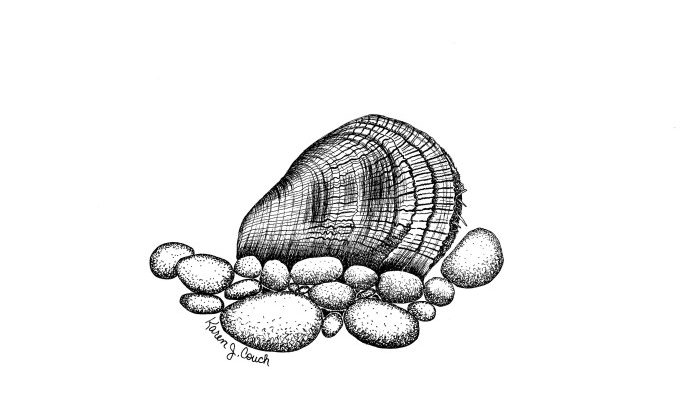
Epioblasma capsaeformis
Epioblasma capsaeformis NatureServe Explorer Species Reports — NatureServe Explorer is a source for authoritative conservation information on more than 50,000 plants, animals and ecological communtities of the U.S and Canada. NatureServe Explorer provides in-depth information on rare and endangered species, but includes common plants and animals too. NatureServe Explorer is a product of NatureServe in collaboration with the Natural Heritage Network.
ITIS Reports — ITIS (the Integrated Taxonomic Information System) is a source for authoritative taxonomic information on plants, animals, fungi, and microbes of North America and the world.The oyster mussel (Epioblasma capsaeformis) is a rare species of freshwater mussel in the family Unionidae. This aquatic bivalve mollusk is native to the Cumberland and Tennessee River systems of Kentucky, Tennessee, Alabama, and Virginia in the United States. It has been extirpated from the states of Georgia and North Carolina. This mussel is elliptical or obovate in shape and reaches a maximum length of 70 mm. The posterior end of males protrudes slightly, while females are more rounded. The periostracum is sunshiny, yellowish green, with green rays over the entire shell. The nacre color is bluish-white to creamy
FWS Digital Media Library — The U.S. Fish and Wildlife Service’s National Digital Library is a searchable collection of selected images, historical artifacts, audio clips, publications, and video. The oyster mussel is a rare species of freshwater mussel in the family Unionidae. This aquatic bivalve mollusk is native to the Cumberland and Tennessee River systems of Kentucky, Tennessee, Alabama, and Virginia in the United States. It has been extirpated from the states of Georgia and North Carolina. It is a federally listed endangered species of the United States.
| Status | Date Listed | Lead Region | Where Listed |
|---|---|---|---|
| Endangered | 01/10/1997 | Southeast Region (Region 4) | Wherever found; Except where listed as Experimental Populations |
| Experimental Population, Non-Essential | 06/14/2001 | Southeast Region (Region 4) | U.S.A. (AL;The free-flowing reach of the Tennessee R. from the base of Wilson Dam downstream to the backwaters of Pickwick Reservoir [about 12 RM (19 km)] and the lower 5 RM [8 km] of all tributaries to this reach in Colbert and Lauderdale Cos., see 17.85(a)) |
| Experimental Population, Non-Essential | 10/15/2007 | Southeast Region (Region 4) | U.S.A. (TN - specified portions of the French Broad and Holston Rivers; see 17.85(b)(1)) |
- Population location: Wherever found; Except where listed as Experimental Populations Listing status: Endangered
- Population location: U.S.A. (AL;The free-flowing reach of the Tennessee R. from the base of Wilson Dam downstream to the backwaters of Pickwick Reservoir [about 12 RM (19 km)] and the lower 5 RM [8 km] of all tributaries to this reach in Colbert and Lauderdale Cos., see 17.85(a)) Listing status: Experimental Population, Non-Essential
- Population location: U.S.A. (TN - specified portions of the French Broad and Holston Rivers; see 17.85(b)(1)) Listing status: Experimental Population, Non-Essential
| 05/24/2004 | Cumberland and Tennessee River Mussels (5 spp.) | View Implementation Progress | Final |
| 05/24/2004 | Cumberland and Tennessee River Mussels (5 spp.) | View Implementation Progress | Final |
| 08/30/2016 | 81 FR 59650 59652 | 5-Year Status Reviews of 22 Southeastern Species; Notice of initiation of reviews; request for information. |
|
| 05/24/2004 | 69 FR 29569 29570 | Availability of the Recovery Plan for Five Freshwater Mussels-- Cumberland Elktoe (Alasmidonta atropurpurea), Oyster Mussel (Epioblasma capsaeformis), Cumberlandian Combshell (Epioblasma brevidens), Purple Bean (Villosa perpurpurea), and Rough Rabbitsfoot (Quadrula cylindrica strigillata) |
|
| 04/22/2003 | 68 FR 19844 19845 | Notice of Availability of an Agency Draft Recovery Plan for Five Freshwater Mussels--Cumberland Elktoe (Alasmidonta atropurpurea), Oyster Mussel (Epioblasma capsaeformis), Cumberlandian Combshell (Epioblasma brevidens), Purple Bean (Villosa perpurpurea), and Rough Rabbitsfoot (Quadrula cylindrica strigillata)--for Review and Comment |
|












